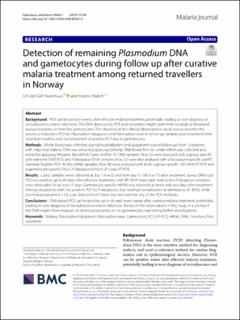| dc.contributor.author | Haanshuus, Christel Gill | |
| dc.contributor.author | Mørch, Kristine | |
| dc.date.accessioned | 2021-06-02T10:31:31Z | |
| dc.date.available | 2021-06-02T10:31:31Z | |
| dc.date.created | 2020-12-14T22:55:06Z | |
| dc.date.issued | 2020 | |
| dc.Published | Malaria Journal. 2020, 19 (1), . | |
| dc.identifier.issn | 1475-2875 | |
| dc.identifier.uri | https://hdl.handle.net/11250/2757354 | |
| dc.description.abstract | Background
PCR can be positive weeks after effective malaria treatment, potentially leading to over diagnose of recrudescence and re-infections. The DNA detected by PCR post-treatment might stem from residuals of destroyed asexual parasites, or from live gametocytes. The objective of this clinical observational study was to describe the presence of positive PCR for Plasmodium falciparum and Plasmodium vivax in follow-up samples post-treatment from returned travellers, and the proportion of positive PCR due to gametocytes.
Methods
Whole blood was collected during hospitalization and outpatient routine follow-up from 13 patients with imported malaria. DNA was extracted applying QIAamp DNA Blood Mini Kit, while mRNA was collected and extracted applying PAXgene Blood RNA Tubes and Kit. All DNA samples (N = 25) were analysed with a genus-specific cytb real-time SYBR PCR, and P. falciparum DNA samples (N = 22) were also analysed with a falciparum-specific varATS real-time TaqMan PCR. All the mRNA samples (N = 18) were analysed with both a genus-specific 18S rRNA RT-PCR and a gametocyte-specific Pfs25 (P. falciparum)/Pvs25 (P. vivax) RT-PCR.
Results
Latest samples were collected at day 1 (n = 2) and from day 11–54 (n = 11) after treatment. Genus DNA cytb PCR was positive up to 49 days after effective treatment, and 18S rRNA transcripts from active P. falciparum parasites were detectable for at least 11 days. Gametocyte-specific mRNA was detected at latest only two days after treatment. Among six patients with late positive PCR for P. falciparum, four had high parasitaemia at admittance (6–30%), while two had parasitaemia < 2%. Late detection of P. vivax was not found by any of the PCR methods.
Conclusions
DNA-based PCR can be positive up to at least seven weeks after curative malaria treatment, potentially leading to over-diagnose of recrudescence and re-infections. Based on the observations in this study, it is unclear if the DNA origins from residuals of destroyed parasites or live gametocytes, warranting further investigations. | en_US |
| dc.language.iso | eng | en_US |
| dc.publisher | BMC | en_US |
| dc.rights | Navngivelse 4.0 Internasjonal | * |
| dc.rights.uri | http://creativecommons.org/licenses/by/4.0/deed.no | * |
| dc.title | Detection of remaining Plasmodium DNA and gametocytes during follow up after curative malaria treatment among returned travellers in Norway | en_US |
| dc.type | Journal article | en_US |
| dc.type | Peer reviewed | en_US |
| dc.description.version | publishedVersion | en_US |
| dc.rights.holder | Copyright 2020 The Authors | en_US |
| dc.source.articlenumber | 296 | en_US |
| cristin.ispublished | true | |
| cristin.fulltext | postprint | |
| cristin.qualitycode | 1 | |
| dc.identifier.doi | 10.1186/s12936-020-03367-6 | |
| dc.identifier.cristin | 1859789 | |
| dc.source.journal | Malaria Journal | en_US |
| dc.source.40 | 19 | |
| dc.source.14 | 1 | |
| dc.identifier.citation | Malaria Journal. 2020, 19, 296 | en_US |
| dc.source.volume | 19 | en_US |

